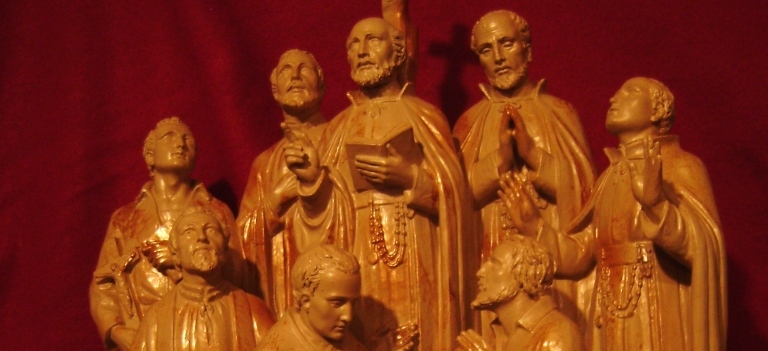When the twelve Galileans reclined at table with Jesus on that first Holy Thursday, they did not know it would be “the last supper.” But surely they sensed a foreboding on that chilly spring evening. This was confirmed by the strange exchange of words and bread between Jesus and Judas; by the Lord’s prophetic challenge to Peter’s boast of heroic loyalty; and by the shocking servitude of the Master at the filthy feet of his followers.
Our scrubbed feet, pedicured toes, and shoes dusted with foot powder do not come close to the reality of that first Holy Thursday night.
Our understanding of the Eucharist, too, has scant in common with that of the apostles who took bread and wine from the hand of the Lord in the candle lit Upper Room in Jerusalem. Whereas blessing and breaking of bread at a Passover meal is the religious duty of the head of household, when had any father added: “This is my Body. . . this is my Blood. . .”
Weird gestures and statements were the stuff of the evening, and must have been unsettling. The Apostles had seen Jesus turn many a custom or concept on its head. But this was different.
He was different. His lengthy discourses after the meal were heavy with impending trouble, and poignant departure. Still he encouraged them and prayed that they would always be in him, as the Father is with him.
Then he left them, taking only the three who were the inner circle of his inner circle. They crossed the Kidron Valley just outside the walls of the city to the Garden of Gethsemani on the Mount of Olives. Jesus met often with them here to rest and to teach.
Again, this time was different. He wanted them to pray with him yet he wondered off to pray alone. When he returned to find them sleeping, he was disturbed, distressed. “Can you not watch one hour with me? Stay awake!” It was an admonishment, and a plea.
What occurred in the Gethsemani olive grove that night is what author Rev. John Bartunek, L.C. calls: “. . .one of the most mysterious events recorded in the Gospels. . . “ and that: “. . .Nowhere else in the Gospels does Jesus even come close to a similar state of debility and confusion; at no other time does He ask His Apostles to stay awake and pray with Him, as if He is running out of strength.” (Bartunek: “Inside the Passion”).
St. Teresa of Avila had a nightly appointment with Jesus in the Garden. She met him there to console him when no one else would. She encouraged her nuns to come to know Jesus by way of his sacred humanity, particularly in the Garden before his arrest when he was most in need.
I, too, go to him in Gethsemani; but not on the night of his agony. I go there on previous nights when Jesus camped there with his disciples. There they were most relaxed, most themselves in questions and disclosures, in humor and conversation. At such times, I imagine them all to be asleep, even the Lord. The scene is moonlight drenched through olive branches. Breezes are soft. I smell on him the aroma of pollens and dust, the sweat of the day that is drying on His skin and tunic. It is very quiet.
I don’t make a sound. I sit on the ground beside him and watch him sleep. He is on his side facing away from me. I watch his shoulders rise and fall with his breathing. Sometimes he pulls his cloak tighter around him; sometimes he turns onto his back and puts his forearm across his eyes and forehead. I wonder if he dreams like everyone else, or if God the Father comes to him in sleep when, like everyone else, his human defenses were down. “. . .he pours gifts on his beloved while he slumbers” (Ps. 127:2).
I could love him and contemplate him like this forever. But he is much more demanding than that. This restful night gives way to spiritual and psychological agony. Friends flee. Branches dappled by moonlight become backdrops of blazing torches. Silence is broken by rough threats that are impatient for the duty at hand.
In my Lenten contemplations, the Passion of Christ is horrific year after year. But I am captured by the scene in the Garden. Taking on the sins of the world, Jesus was covered with filth, pain, mockery, and ingratitude that bent him to the ground, even before the guards arrived to bind him and take him way.
Artists invariably depict his beads of sweat on his forehead and holy face. But our bodies, in intense excursion, sweat all over. Look at the shirt of a jogger with it darkened areas on the back, chest, and neck. Likewise, the bloody sweat of the Lord on his garment surely stuck to his skin. Wrestling with the demons behind every sin of the world, how is it his head didn’t virtually explode.
My tears swamp the garden ground, and I see once again why, in the Sorrowful Mysteries of the Rosary, the fruit of the Mystery of the Agony in the Garden is “Sorrow for Sin.”
I retreat back to the sleeping Jesus in the familiar cool and quiet of Gethsemani, a place both restful in the presence with the Lord, and intense in sorrow for my sins.
And from there I follow him. No cross, no crown. There is no detour around the Way of the Cross. As the Lord said as the Betrayer arrived: “Rise. Let us be on our way” (Mk. 14:42).

beautiful read for today, Holy Thursday…
Thanks, Beth. So beautifully written. Are you working on your book?
Love, Pat
Sent from my iPhone
>
A very powerful and thought provoking meditation as we prepare to enter Our Lord’s passion.